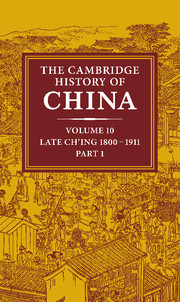Book contents
- Frontmatter
- 1 Introduction: the old order
- 2 Ch'ing Inner Asia c. 1800
- 3 Dynastic decline and the roots of rebellion
- 4 The Canton trade and the Opium War
- 5 The creation of the treaty system
- 6 The Taiping Rebellion
- 7 Sino-Russian relations, 1800–62
- 8 The heyday of the Ch'ing order in Mongolia, Sinkiang and Tibet
- 9 The Ch'ing Restoration
- 10 Self-strengthening: the pursuit of Western technology
- 11 Christian missions and their impact to 1900
- Bibliographical essays
- Bibliography
- Genealogical chart
- Glossary
- Index
- References
2 - Ch'ing Inner Asia c. 1800
Published online by Cambridge University Press: 28 March 2008
- Frontmatter
- 1 Introduction: the old order
- 2 Ch'ing Inner Asia c. 1800
- 3 Dynastic decline and the roots of rebellion
- 4 The Canton trade and the Opium War
- 5 The creation of the treaty system
- 6 The Taiping Rebellion
- 7 Sino-Russian relations, 1800–62
- 8 The heyday of the Ch'ing order in Mongolia, Sinkiang and Tibet
- 9 The Ch'ing Restoration
- 10 Self-strengthening: the pursuit of Western technology
- 11 Christian missions and their impact to 1900
- Bibliographical essays
- Bibliography
- Genealogical chart
- Glossary
- Index
- References
Summary
Three changes occurred in the eighteenth century that set the course of China's subsequent history. The change that has received the most scholarly attention is the solid establishment of Europe's presence. But two other changes may prove to have been of greater significance in the long run. One of these was a doubling of the territorial size of the Chinese empire. The other was a doubling of the Han Chinese population. The interplay of these three factors has set the direction of China's history in modern times.
By the opening decades of the nineteenth century the dimensions of the Middle Kingdom's effective sovereignty were greater than at any time in her history, and China was on the threshold of a political, economic and cultural metamorphosis. This metamorphosis, often seen as ‘modernization’, came not only as the result of the influence exerted, directly and indirectly, by European civilization but also as a result of China's internal social evolution. The indigenous social and economic processes of a demographically and territorially expanded China, no less than pressures from outside, have underlain the modern transformation of Chinese society that is still under way.
Before 1800 the focus of Ch'ing history was on Inner Asia – its conquest, its politics, the swallowing and digesting of immense, culturally diverse areas by a single, increasingly Han Chinese empire. After 1800 that emphasis began to shift to the interior of China proper and to the coast. In the nineteenth century Ch'ing Inner Asia commenced being slowly absorbed into an expanding China and began to come under the influence of Han Chinese culture.
- Type
- Chapter
- Information
- The Cambridge History of China , pp. 35 - 106Publisher: Cambridge University PressPrint publication year: 1978
References
- 16
- Cited by

